Bretons
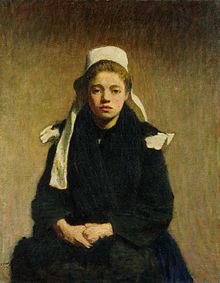 Une Jeune Bretonne( "A young Breton woman"), painting byRoderic O'Conor | |
| Total population | |
|---|---|
| c.6–8 million | |
| Regions with significant populations | |
| France | 6–7 million |
| Brittany | 3,318,904[1][note 1] |
| Loire-Atlantique | 1,394,909[2][note 2] |
| Île-de-France | 1,500,000[3] |
| Le Havre | 70,000[4] |
| Canada (predominantlyQuebec) | 17,465[5] |
| Languages | |
| French,Breton,Gallo | |
| Religion | |
| PredominantlyRoman Catholic | |
| Related ethnic groups | |
| Celts:Britons(Cornish,EnglishandWelsh) andGaels(Irish,ManxandScots)[6] | |
TheBretons(/ˈbrɛtɒnz,-ənz,-ɒ̃z/;[7]Breton:BretonedorVretoned,[8]Breton pronunciation:[breˈtɔ̃nɛt]) are anethnic groupnative toBrittany,north-westernFrance.They trace their heritage to groups ofBrittonicspeakers who emigrated fromsouthwestern Great Britain,particularlyCornwallandDevon,mostly during theAnglo-Saxon settlement of Britain.They migrated in waves from the 3rd to 9th century (most heavily from 450 to 600) intoArmorica,which was subsequently named Brittany after them.[9]
The main traditional language of Brittany isBreton(Brezhoneg), spoken inLower Brittany(i.e., the western part of the peninsula). Breton is spoken by around 206,000 people as of 2013.[10]The other principal minority language of Brittany isGallo;Gallo is spoken only in Upper Brittany, where Breton used to be spoken as well but it has seen a decline and has been less dominant in Upper Brittany since around the year 900. Currently, most Bretons' native language isstandard French.
Historically, Brittany and its people have been counted as one of the sixCeltic nations.The actual number of Bretons in Brittany and France as a whole is difficult to assess as thegovernment of Francedoes not collect statistics on ethnicity. The population of Brittany, based on a January 2007 estimate, was 4,365,500.[11]There is reason to believe that this number includes the department ofLoire-Atlantique,which theVichy governmentseparated from historical Brittany in 1941.[12]
It is said that, in 1914, over one million people spoke Breton west of the boundary between the Breton and Gallo-speaking region—roughly 90% of the population of the western half of Brittany. In 1945, Breton speakers consisted about 75% of the population. Today, in all of Brittany, at most 20% of the population can speak Breton. 75% of the estimated 200,000 to 250,000 Breton speakers using Breton as an everyday language are over the age of 65.
A strong historical emigration has created a Breton diaspora within the French borders and in theoverseas departments and territories of France;it is mainly established in theParis area,where more than one million people claim Breton heritage. Many Breton families have also migrated to the Americas, predominantly toCanada(mostlyQuebecandAtlantic Canada) and theUnited States.The only places outside Brittany that still retain significant Breton customs are inÎle-de-France(mainlyQuartier de Montparnassein Paris),Le HavreandÎles des Saintes,where a group of Breton families settled in the mid-17th century.
History[edit]

Late Roman era[edit]
In the late fourth century, large numbers of British auxiliary troops in the Roman army may have been stationed inArmorica.The ninth-centuryHistoria Brittonumstates that the emperorMagnus Maximus,who withdrew Roman forces from Britain, settled his troops in the province.
NenniusandGildasmention a second wave of Britons settling in Armorica in the following century to escape the invadingAnglo-SaxonsandScoti.Modern archaeology also supports a two-wave migration.[13]
It is generally accepted that the Brittonic speakers who arrived gave the region its current name as well as theBreton language,Brezhoneg,a sister language to Welsh and Cornish.
There are numerous records ofCeltic Christianmissionaries migrating from Britain during the second wave of Breton colonisation, especially the legendaryseven founder-saints of Brittanyas well asGildas.
As in Cornwall, many Breton towns are named after these early saints. The Irish saintColumbanuswas also active in Brittany and is commemorated atSaint-ColumbaninCarnac.
Early Middle Ages[edit]
In the EarlyMiddle Ages,Brittany was divided into three kingdoms—Domnonée,Cornouaille(Kernev), and Bro Waroc'h (Broërec)—which eventually were incorporated into theDuchy of Brittany.The first two kingdoms seem to derive their names from the homelands of the migrating tribes in Britain, Cornwall (Kernow) andDevon(Dumnonia). Bro Waroc'h ( "land ofWaroch",nowBro Gwened) derives from the name of one of the first known Breton rulers, who dominated the region ofVannes(Gwened). The rulers of Domnonée, such asConomor,sought to expand their territory, claiming overlordship over all Bretons, though there was constant tension between local lords.[citation needed]
Breton participation in the Norman Conquest of England[edit]
Bretons were the most prominent of the non-Norman forces in theNorman conquest of England.A number of Breton families were of the highest rank in the new society and were tied to the Normans by marriage.[14]
The ScottishClan Stewartand the royalHouse of Stuarthave Breton origins.Alan Rufus,also known as Alan the Red, was both a cousin and knight in the retinue of William the Conqueror. Following his service at Hastings, he was rewarded with large estates inYorkshire.At the time of his death, he was by far the richest noble in England. His manorial holding atRichmondensured a Breton presence in northern England. TheEarldom of Richmondlater became anappanageof the Dukes of Brittany.
Modern Breton identity[edit]
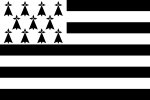
Many people throughout France claim Breton ethnicity, including a few French celebrities such asMarion Cotillard,[15]Suliane Brahim,[16]Malik Zidi,[17]Patrick Poivre d'Arvor,Yoann Gourcuff,Nolwenn LeroyandYann Tiersen.[18]
After 15 years of disputes in the French courts, the European Court of Justice recognized Breton Nationality for the six children of Jean-Jacques and Mireille Manrot-Le Goarnig; they are "European Citizens of Breton Nationality".[19]In 2015, Jonathan Le Bris started a legal battle against the French administration to claim this status.
Breton diaspora[edit]
The Breton community outside Brittany includes groups of Bretons in the GreaterParisarea,Le Havre,andToulon.Groups with Breton heritage also live in other countries, most notably in Canada and the United States. In Paris, Bretons used to settle in the neighborhood around the Montparnasse train station, which is also the terminus of the Paris-Brestrailway.
Bretons in the United States[edit]
Famous Breton Americans and Americans of Breton descent includeJohn James Audubon,Jack Kerouac,andJoseph-Yves Limantour.
From 1885 to 1970, several thousand Bretons migrated to the United States, many of them leaving the Black Mountains ofMorbihan.[20]In June 2020, a replica of theStatue of Libertywas dedicated inGourin,Morbihan, to celebrate the legacy of these emigrants.
Sylvester Stalloneis of partial Breton descent through his mother.
Culture[edit]
Religion[edit]
The Breton people are predominantly members of theCatholic Church,with minorities in theReformed Church of Franceandnon-religious people.Brittany was one of the most staunchly Catholic regions in all of France. Attendance at Sundaymassdropped during the 1970s and the 1980s; however, other religious practices, such aspilgrimages,have experienced a revival. This includes theTro Breizh,which takes place in the shrines of the seven founding saints of Breton Christianity. The Christian tradition is widely respected by both believers and nonbelievers, who see it as a symbol of Breton heritage andculture.
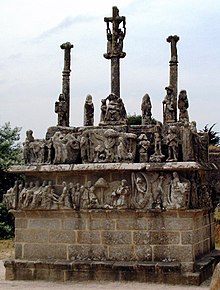
Breton religious tradition places great emphasis on the "Seven Founder Saints":
- Paul Aurelian,atSaint-Pol-de-Léon(Breton:Kastell-Paol),
- Tudwal(Sant Tudwal), atTréguier(Breton:Landreger),
- Brioc,atSaint-Brieuc(Breton:Sant-Brieg,Gallo:Saent-Berioec),
- Malo,atSaint-Malo(Breton:Sant-Maloù,Gallo:Saent-Malô),
- Samson of Dol,atDol-de-Bretagne(Breton:Dol,Gallo:Dóu),
- Padarn,atVannes(Breton:Gwened),
- Corentin(Sant Kaourintin), atQuimper(Breton:Kemper).
Pardons[edit]
Apardonis the patron saint'sfeast dayof theparish.It often begins with a procession followed by mass in honour of the saint.Pardonsare often accompanied by small village fairs. The three most famouspardonsare:
- Sainte-Anned'Auray/Santez-Anna-Wened
- Tréguier/Landreger, in honour of St Yves
- Locronan/Lokorn, in honour of StRonan,with atroménie(a procession, 12 km long) and numerous people in traditional costumes
Tro Breizh[edit]
There is an ancientpilgrimagecalled theTro Breizh(tour of Brittany) which involves pilgrims walking around Brittany from the grave of one of the Seven Founder Saints to another. Currently, pilgrims complete the circuit over the course of several years. In 2002, the Tro Breizh included a special pilgrimage to Wales, symbolically making the reverse journey of the Welshmen Paul Aurelian, Brioc, and Samson. According to Breton religious tradition, whoever does not make the pilgrimage at least once in his lifetime will be condemned to make it after his death, advancing only by the length of his coffin every seven years.[21]
Folklore and traditional belief[edit]
Some pagan customs from the old pre-Christian tradition remain thefolkloreof Brittany. The most powerful folk figure is theAnkouor the "Reaper of Death".[citation needed]
Language[edit]
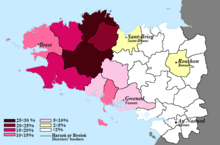
There are four main Breton dialects: Gwenedeg (Vannes), Kerneveg (Cornouaille), Leoneg (Leon) and Tregerieg (Trégor), which have varying degrees of mutual intelligibility. In 1908, a standard orthography was devised. The fourth dialect, Gwenedeg, was not included in this reform, but was included in the later orthographic reform of 1941.[22]
The Breton language is a very important part of Breton identity. Breton itself is one of theBrittonic languagesand is closely related toCornishand more distantly toWelsh.[23]Breton is thus anInsular Celtic languageand is more distantly related to the long-extinctContinental Celtic languages,such asGaulish,that were formerly spoken on the European mainland, including the areas colonised by the ancestors of the Bretons.
In eastern Brittany, a regionallangue d'oïl,Gallo,developed. Gallo shares certainareal featuressuch as points of vocabulary, idiom, and pronunciation with Breton, but is aRomance language.Neither language has official status under French law; however, some still use Breton as an everyday language. As of the 1980s, bilingual roadsides have been placed around the department as a way to regain a sense of cultural heritage.[24]
From 1880 to the mid-20th century, Breton was banned from the French school system and children were punished for speaking it. This was similar to Britain's enforcement of English, not Welsh, being used in Welsh schools during the 18th and early 19th centuries. The situation changed in 1951 with theDeixonne Law.This law allowed Breton language and culture to be taught 1–3 hours a week in the public school system on the provision that a teacher was both able and prepared to do so. In modern times, a number of schools and colleges have emerged with the aim of providing Breton-medium education or bilingual Breton/French education.[22]
Breton-language media[edit]
There are a number of Breton language weekly and monthly magazines.[22]Newspapers, magazines and online journals available in Breton includeAl Lanv(based in Quimper),[25]Al Liamm,[26]Louarnig-Rouzig,andBremañ.
Several radio stations broadcast in the Breton language:Arvorig FM,France Bleu Armorique,France Bleu Breizh-Izel,Radio Bro Gwened,Radio Kerne,andRadio Kreiz Breizh.
Television programmes in Breton are available onBrezhoweb,[27]France 3 Breizh,France 3 Iroise,TV BreizhandTV Rennes.
Music[edit]

Fest-noz[edit]
Afest-nozis a traditional festival (essentially a dance) inBrittany.Manyfestoù-nozare held outside Brittany, taking regional Breton culture outside Brittany. Although the traditional dances of thefest-nozare old, some dating back to theMiddle Ages,thefest-noztradition is itself more recent, dating back to the 1950s. Fest-Noz was officially registered on Wednesday, December 5, 2012, byUNESCOon the "Representative List of the Intangible Cultural Heritage of Humanity."
Traditional dance[edit]
There are many traditional Breton dances, the most well-known beinggavottes,an dro,thehanter dro,and theplinn.During thefest-noz,most dances are practised in a chain or in a circle with participants locking pinky fingers; however, there are also dances in pairs and choreographed dances with sequences and figures.
Traditional Breton music[edit]
Two main types of Breton music are a chorala cappellatradition calledkan ha diskan,and music involving instruments, including purely instrumental music. Traditional instruments include thebombard(similar to an oboe) and two types ofbagpipes(veuzeandbinioù kozh). Other instruments often found are the diatonicaccordion,theclarinet,and occasionallyviolinas well as thehurdy-gurdy.AfterWorld War II,theGreat Highland bagpipe(andbinioù bras) became commonplace in Brittany through thebagadoù(Breton pipe bands) and thus often replaced thebinioù-kozh.The basicclarinet(treujenn-gaol) had all but disappeared but has regained popularity over the past few years.
Modern Breton music[edit]
Nowadays groups with many different styles of music may be found, ranging fromrocktojazzsuch asRed Cardell,ethno-rock,DiwallandSkeduzas well aspunk.Some modernfest-nozgroups also use electronic keyboards and synthesisers, for exampleStrobinell,Sonerien Du,Les Baragouineurs,andPlantec.
Breton cuisine[edit]
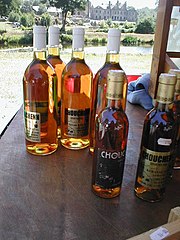
Breton cuisine contains many elements from the wider French culinary tradition. Local specialities include:
- Crêpe Bretonne
- Chouchenn– a type of Bretonmead
- Fars forn(far breton) – a sweetsuet puddingwith prunes
- Kouign-amann– butter pastry
- Krampouezh(crêpesorgalettes) – thin pancakes made either fromwheatorbuckwheatflour; usually eaten as a main course
- Lambig– appleeau de vie
- Sistr–cider
- Caramel au beurre salé- salted butter caramel
Symbols of Brittany[edit]
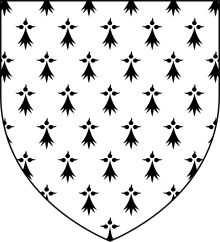
Traditional Breton symbols of Brittany include:

- The national anthemBro Gozh ma Zadoù,based on the WelshHen Wlad Fy Nhadau.
- The traditional motto of the former Dukes of Brittany isKentoc'h mervel eget bezañ saotretin Breton, orPotius mori quam fœdariinLatin.
- The "national day" is observed on 1 August,[28]theFeastofSaint Erwann(Saint Yves). Although, the "Gouel Breizh"(Festival of Brittany), is the biggest Breton national event, taking place every year during the week of the 19th of May: the day Saint Yves died.
- The ermine is an important symbol of Brittany reflected in the ancient blazons of the Duchy of Brittany and also in thechivalric order,L’Ordre de l’Hermine(The Order of the Ermine).
- Thetriskeleis also an important symbol in Breton culture. The triskele is a traditional Celtic symbol that the Bretons use to connect them to their Celtic heritage.
See also[edit]
- Breton nationalism
- British migration to France
- Brythons
- List of Breton authors
- List of Breton poets
- List of Breton saints
- Wikipedia in Breton
Images of Bretons[edit]
-
William-Adolphe Bouguereau,Breton Brother and Sister
-
Paul Gauguin,Breton Girl
-
Thebagadof Lann-Bihoué of theFrench Navy
-
Breton pipe player
Notes[edit]
- ^Legal population of theadministrative region of Brittanyin 2017
- ^Legal population ofLoire-Atlantiquein 2017
References[edit]
- ^"Populations légales des régions en 2017".INSEE.Retrieved13 September2020.
- ^"Populations légales des départements en 2017".INSEE.Retrieved13 September2020.
- ^Rolland, Michel."La Bretagne à Paris".Archived fromthe originalon 2016-11-30.Retrieved31 December2016.
- ^"Ils sont 70 000! Notre dossier sur les Bretons du Havre".Archived fromthe originalon 20 December 2016.Retrieved31 December2016.
- ^"Canada Census Profile 2021".Census Profile, 2021 Census.Statistics Canada Statistique Canada. 7 May 2021.Retrieved3 January2023.
- ^Ed. Wade Davis and K. David Harrison (2007).Book of Peoples of the World.National Geographic Society. p. 225.ISBN978-1-4262-0238-4.
- ^Wells, John C.(2008).Longman Pronunciation Dictionary(3rd ed.). Longman.ISBN978-1-4058-8118-0.
- ^After the definite article, B > V (SeeBreton mutations)
- ^Koch, John(2005).Celtic Culture: A Historical Encyclopedia.ABL-CIO. p. 275.ISBN978-1-85109-440-0.RetrievedSeptember 29,2012.
- ^"Breton".Ethnologue.Retrieved2017-06-09.
- ^"Breton Language".Retrieved31 December2016.
- ^"France: Bretagne population 2023".Statista.Retrieved2023-05-03.
- ^Léon Fleuriot,Les origines de la Bretagne: l’émigration,Paris, Payot, 1980.
- ^Keats-Rohan 1991,The Bretons and Normans of England 1066-1154Archived2011-07-24 at theWayback Machine
- ^"Marion Cotillard: 'Before my family, everything was dedicated to the character'".The Guardian.August 2, 2014.
- ^"Suliane Brahim, le Grand Jeu".Libération.February 28, 2018.
- ^ifranceArchivedAugust 27, 2008, at theWayback Machine
- ^"Yann Tiersen: ∞ (Infinity) & the Origin of Its Language".Retrieved31 December2016.
- ^"Goarnig Kozh a livré son dernier combat".Retrieved31 December2016.
- ^Lysiane Bernard, L'émigration « américaine » de la région de Gourin et ses conséquences géographiques. Norois, 1962, pp. 185-195
- ^Bretagne: poems(in French), by Amand Guérin, published by P. Masgana, 1842: page 238.
- ^abc"Breton language, Alpha bet and pronunciation".Retrieved31 December2016.
- ^"Breton language".Retrieved31 December2016.
- ^Leizaola, Aitzpea; Egaña, Miren (2007),"Le paysage linguistique",L'Aménagement du territoire en Pays basque,Gasteiz: Zarautz Dakit, pp. 81–102,ISBN978-84-932368-3-0,retrieved2023-05-03
- ^Allanv.microopen.orgArchivedMay 9, 2009, at theWayback Machine
- ^"Al Liamm - Degemer".Retrieved31 December2016.
- ^Website of the web streaming channel Brezhoweb:https:// brezhoweb.bzh/
- ^Pierre Le Baud, Cronicques & Ystoires des Bretons.
Bibliography[edit]
- Léon Fleuriot,Les origines de la Bretagne,Bibliothèque historique Payot, 1980, Paris, (ISBN2-228-12711-6)
- Christian Y. M. Kerboul,Les royaumes brittoniques au Très Haut Moyen Âge,Éditions du Pontig/Coop Breizh, Sautron – Spézet, 1997, (ISBN2-84346-030-1)
- Morvan Lebesque,Comment peut-on être Breton? Essai sur la démocratie française,Éditions du Seuil, coll. « Points », Paris, 1983, (ISBN2-02-006697-1)
- Myles Dillon, Nora Kershaw Chadwick, Christian-J. Guyonvarc'h and Françoise Le Roux,Les Royaumes celtiques,Éditions Armeline, Crozon, 2001, (ISBN2-910878-13-9).
External links[edit]
Breizh.net – a non-profit association dedicated to the promotion of Brittany and the Breton language on the InternetBreizh.net






